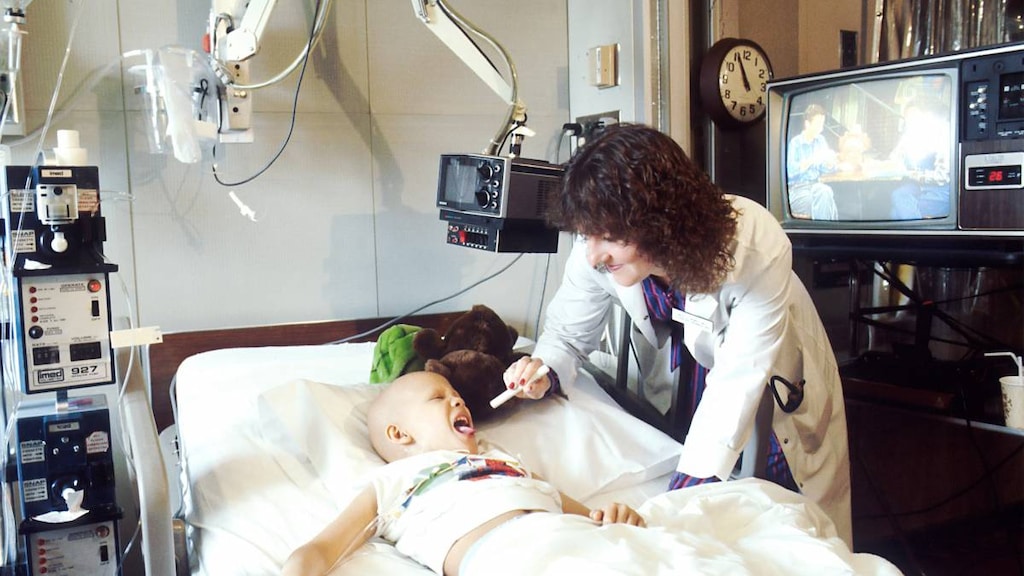Dosage Forms
Excipient information presented when available (limited, particularly for generics); consult specific product labeling.
Solution Reconstituted, Intravenous:
Dacogen: 50 mg (1 ea)
Generic: 50 mg (1 ea)
Solution Reconstituted, Intravenous [preservative free]:
Generic: 50 mg (1 ea)
Pharmacology
Mechanism of Action
Decitabine is a hypomethylating agent. After phosphorylation, decitabine is incorporated into DNA and inhibits DNA methyltransferase causing hypomethylation and subsequent cell death (within the S-phase of the cell cycle).
Pharmacokinetics/Pharmacodynamics
Distribution
~63 to 89 L/m2 (Cashen 2008)
Metabolism
Possibly via deamination by cytidine deaminase
Half-Life Elimination
~0.5 to 0.6 hours
Use: Labeled Indications
Myelodysplastic syndromes: Treatment of myelodysplastic syndromes (MDS), including previously treated and untreated, de novo and secondary MDS of all French-American-British (FAB) subtypes (refractory anemia, refractory anemia with ringed sideroblasts, refractory anemia with excess blasts, refractory anemia with excess blasts in transformation, and chronic myelomonocytic leukemia) and intermediate-1, intermediate-2, and high-risk International Prognostic Scoring System (IPSS) groups
Use: Off Label
Acute myeloid leukemiab
Data from a multicenter phase II study and a multicenter open-label phase III trial in older patients with acute myeloid leukemia (AML) support the use of decitabine for the treatment of newly diagnosed AML Cashen 2010, Kantarjian 2012.
Contraindications
There are no contraindications listed in the manufacturer's labeling.
Dosage and Administration
Dosing: Adult
Acute myeloid leukemia (off-label use): Adults ≥60 years: IV: 20 mg/m2 over 1 hour daily for 5 days every 28 days until relapse, disease progression, or unacceptable toxicity (Cashen 2010; Kantarjian 2012).
Myelodysplastic syndromes: IV:
3-day regimen: 15 mg/m2 over 3 hours every 8 hours (45 mg/m2/day) for 3 days (135 mg/m2/cycle); repeat every 6 weeks upon hematologic recovery (ANC ≥1,000/mm3 and platelets ≥50,000/mm3); treatment is recommended for a minimum of 4 cycles (complete or partial response may take longer than 4 cycles).
or
5-day regimen: 20 mg/m2 over 1 hour once daily for 5 days; repeat every 4 weeks upon hematologic recovery (ANC ≥1,000/mm3 and platelets ≥50,000/mm3); treatment is recommended for a minimum of 4 cycles (complete or partial response may take longer than 4 cycles).
Dosing: Geriatric
Refer to adult dosing.
Dosing: Adjustment for Toxicity
Myelodysplastic syndromes: IV:
Hematologic toxicity: ANC <1,000/mm3 and platelets <50,000/mm3: Delay subsequent treatment cycles until hematologic recovery to ANC ≥1,000/mm3 and platelets ≥50,000/mm3.
3-day regimen: Hematologic toxicity lasting >6 weeks: Delay the next decitabine cycle and reduce the next dose as follows:
Hematologic toxicity lasting >6 weeks but <8 weeks: Delay dose for up to 2 weeks and upon re-initiation, temporarily reduce decitabine dose to 11 mg/m2 every 8 hours (33 mg/m2/day) for 3 days (99 mg/m2/cycle).
Hematologic toxicity lasting >8 weeks but <10 weeks: Assess bone marrow for disease progression; in the absence of disease progression, delay dose for up to 2 more weeks and reduce decitabine dose to 11 mg/m2 every 8 hours (33 mg/m2/day) for 3 days (99 mg/m2/cycle); maintain or increase dose with subsequent cycles if clinically indicated.
Nonhematologic toxicity:
Active or uncontrolled infection: Temporarily withhold decitabine; do not resume decitabine until after resolution.
Reconstitution
IV: Reconstitute vial with 10 mL of room temperature SWFI to a concentration of 5 mg/mL. Further dilute for infusion. If product will be administered within 15 minutes, dilute with room temperature (20°C to 25°C [68°F to 77°F]) NS or D5W to a final concentration of 0.1 to 1 mg/mL. If administration will be delayed >15 minutes, dilute with cold (2°C to 8°C [36°F to 46°F]) NS or D5W to a final concentration of 0.1 to 1 mg/mL.
Administration
IV: Infuse over 1 to 3 hours (depending on dosing regimen). For the treatment of myelodysplastic syndromes, administer by IV infusion over 3 hours (15 mg/m2 dose) or over 1 hour (20 mg/m2 dose). Premedication with antiemetics is recommended (according to the manufacturer). For the treatment of acute myeloid leukemia (off-label use), administer by IV infusion over 1 hour (Cashen 2010; Kantarjian 2012).
SubQ (off-label route): Subcutaneous administration of the 5-day decitabine regimen has been reported in a limited number of patients with higher-risk myelodysplastic syndromes; however, the complete response rate was lower in the subcutaneous arm compared to the 5-day regimen administered IV (Kantarjian 2007a; Kantarjian 2007b). Other schedules of subcutaneous decitabine have been reported in a small study in patients with low- or intermediate-risk myelodysplastic syndromes (Garcia-Manero 2013). Multiple subcutaneous injections may be required to administer a single dose (depending on institutional subcutaneous volume policy).
Storage
Store intact vials at 25°C (77°F); excursions permitted to 15°C to 30°C (59°F to 86°F). Solutions diluted for infusion in NS or D5W may be stored for up to 4 hours prior to infusion refrigerated at 2°C to 8°C (36°F to 46°F) if prepared with cold infusion fluids. Infusion should begin within 15 minutes of preparation if room temperature infusion solutions are utilized.
Drug Interactions
BCG (Intravesical): Myelosuppressive Agents may diminish the therapeutic effect of BCG (Intravesical). Avoid combination
Chloramphenicol (Ophthalmic): May enhance the adverse/toxic effect of Myelosuppressive Agents. Monitor therapy
Cladribine: May enhance the myelosuppressive effect of Myelosuppressive Agents. Avoid combination
CloZAPine: Myelosuppressive Agents may enhance the adverse/toxic effect of CloZAPine. Specifically, the risk for neutropenia may be increased. Monitor therapy
Deferiprone: Myelosuppressive Agents may enhance the neutropenic effect of Deferiprone. Management: Avoid the concomitant use of deferiprone and myelosuppressive agents whenever possible. If this combination cannot be avoided, monitor the absolute neutrophil count more closely. Consider therapy modification
Dipyrone: May enhance the adverse/toxic effect of Myelosuppressive Agents. Specifically, the risk for agranulocytosis and pancytopenia may be increased Avoid combination
Lenograstim: Antineoplastic Agents may diminish the therapeutic effect of Lenograstim. Management: Avoid the use of lenograstim 24 hours before until 24 hours after the completion of myelosuppressive cytotoxic chemotherapy. Consider therapy modification
Lipegfilgrastim: Antineoplastic Agents may diminish the therapeutic effect of Lipegfilgrastim. Management: Avoid concomitant use of lipegfilgrastim and myelosuppressive cytotoxic chemotherapy. Lipegfilgrastim should be administered at least 24 hours after the completion of myelosuppressive cytotoxic chemotherapy. Consider therapy modification
Mesalamine: May enhance the myelosuppressive effect of Myelosuppressive Agents. Monitor therapy
Palifermin: May enhance the adverse/toxic effect of Antineoplastic Agents. Specifically, the duration and severity of oral mucositis may be increased. Management: Do not administer palifermin within 24 hours before, during infusion of, or within 24 hours after administration of myelotoxic chemotherapy. Consider therapy modification
Promazine: May enhance the myelosuppressive effect of Myelosuppressive Agents. Monitor therapy
Adverse Reactions
>10%:
Cardiovascular: Peripheral edema (25% to 27%), edema (5% to 18%), heart murmur (16%), hypotension (6% to 11%)
Central nervous system: Fatigue (46%), headache (23% to 28%), insomnia (14% to 28%), rigors (22%), dizziness (18% to 21%), chills (16%), pain (5% to 13%), confusion (8% to 12%), lethargy (12%), hypoesthesia (11%), anxiety (9% to 11%)
Dermatologic: Pallor (23%), skin rash (11% to 19%), erythema (5% to 14%), cellulitis (9% to 12%), pruritus (9% to 11%)
Endocrine & metabolic: Hyperglycemia (6% to 33%), hypoalbuminemia (7% to 24%), hypomagnesemia (5% to 24%), hypokalemia (12% to 22%), hyponatremia (19%), hyperkalemia (13%)
Gastrointestinal: Nausea (40% to 42%), constipation (30% to 35%), diarrhea (28% to 34%), vomiting (16% to 25%), anorexia (≤8% to 23%), decreased appetite (≤8% to 23%), abdominal pain (5% to 14%), stomatitis (11% to 12%), dyspepsia (10% to 12%)
Hematologic & oncologic: Neutropenia (38% to 90%; grades 3/4: 37% to 87%; recovery 28 to 50 days), thrombocytopenia (27% to 89%; grades 3/4: 24% to 85%), anemia (31% to 82%; grades 3/4: 22%), petechia (12% to 39%), febrile neutropenia (20% to 29%; grades 3/4: 23%), leukopenia (6% to 28%; grades 3/4: 22%), bruise (9% to 22%), oral mucosal petechiae (13%), lymphadenopathy (12%)
Hepatic: Hyperbilirubinemia (6% to 14%), increased serum alkaline phosphatase (11%)
Local: Localized tenderness (11%)
Neuromuscular & skeletal: Arthralgia (17% to 20%), limb pain (18% to 19%), back pain (17% to 18%), weakness (15%)
Respiratory: Cough (27% to 40%), dyspnea (29%), pneumonia (20% to 22%), pharyngitis (16%), rales (8% to 14%), epistaxis (13%)
Miscellaneous: Fever (6% to 53%), lesion (5% to 11%)
5% to 10%:
Cardiovascular: Tachycardia (8%), chest wall pain (7%), chest pain (≤6% to 7%), chest discomfort (≤6% to 7%), facial edema (6%), hypertension (6%), cardiac failure (5%)
Central nervous system: Depression (9%), falling (8%), malaise (5%), mouth pain (5%)
Dermatologic: Alopecia (8%), xeroderma (8%), urticaria (6%), catheter site erythema (5%), night sweats (5%)
Endocrine & metabolic: Hyperuricemia (10%), weight loss (9%), increased lactate dehydrogenase (8%), dehydration (6% to 8%), hypochloremia (6%), increased serum bicarbonate (6%), decreased serum bicarbonate (5%), hypoproteinemia (5%)
Gastrointestinal: Mucosal inflammation (9%), gingival hemorrhage (8%), hemorrhoids (8%), loose stools (7%), tongue ulcer (7%), oral candidiasis (6%), toothache (6%), dysphagia (5% to 6%), abdominal distention (5%), gastroesophageal reflux disease (5%), glossalgia (5%), oral mucosa ulcer (lip: 5%)
Genitourinary: Urinary tract infection (7%), dysuria (6%)
Hematologic & oncologic: Hematoma (5%), pancytopenia (5%), thrombocythemia (5%)
Hepatic: Ascites (10%), increased serum AST (10%), decreased serum bilirubin (5%)
Hypersensitivity: Transfusion reaction (7%)
Infection: Candidiasis (10%), bacteremia (5% to 8%), staphylococcal infection (7%), tooth abscess (5%)
Local: Catheter infection (8%), catheter pain (5%), swelling at injection site (5%)
Neuromuscular & skeletal: Myalgia (5% to 9%), muscle spasm (7%), ostealgia (6%), musculoskeletal pain (≤6%; includes discomfort)
Ophthalmic: Blurred vision (6%)
Otic: Otalgia (6%)
Renal: Polyuria (5%)
Respiratory: Hypoxia (10%), upper respiratory tract infection (10%), abnormal breath sounds (5% to 10%), pharyngolaryngeal pain (8%), pulmonary edema (6%), sinusitis (5% to 6%), pleural effusion (5%), post nasal drip (5%), pulmonary signs and symptoms (crepitations: 5%), sinus congestion (5%)
<5%, postmarketing, and/or case reports: Abscess (peridiverticular), acute cardiorespiratory failure, anaphylaxis, atrial fibrillation, cardiomyopathy, catheter site hemorrhage, cholecystitis, fungal infection, gastrointestinal hemorrhage, gingival pain, hemoptysis, hypersensitivity reaction, intracranial hemorrhage, mental status change, myocardial infarction, mycobacterium avium complex, nodule (pulmonary), pulmonary aspergillosis, pulmonary embolism, pulmonary infection (pseudomonas), pulmonary infiltrates, renal failure, sepsis, splenomegaly, supraventricular tachycardia, Sweet’s syndrome (acute febrile neutrophilic dermatosis), urethral bleeding
Warnings/Precautions
Concerns related to adverse effects:
- Bone marrow suppression: Myelosuppression (neutropenia, thrombocytopenia, and anemia) commonly occurs with decitabine, including Grades 3 and 4 neutropenia, thrombocytopenia, and neutropenic fever; may be serious or fatal. Monitor blood counts (including platelets) at baseline, prior to each cycle, and as needed to monitor response and for toxicity. Myelosuppression and worsening neutropenia are more common in first two treatment cycles and may not correlate with progression of underlying MDS. Hematologic toxicity may require dose reduction, treatment delay, discontinuation, growth factor support, and/or antimicrobial agents. Monitor for infection.
Concurrent drug therapy issues:
- Drug-drug interactions: Potentially significant interactions may exist, requiring dose or frequency adjustment, additional monitoring, and/or selection of alternative therapy. Consult drug interactions database for more detailed information.
Monitoring Parameters
Monitor CBC with differential and platelets (prior to treatment and with each cycle; more frequently if needed); liver enzymes (prior to treatment initiation and periodically); serum creatinine (prior to treatment initiation and periodically); pregnancy test prior to treatment in females of reproductive potential.
Pregnancy
Pregnancy Considerations
Based on the mechanism of action and information from animal reproduction studies, decitabine may cause fetal harm if exposure occurs during pregnancy. Information related to the use of decitabine in pregnancy is limited.
Evaluate pregnancy status prior to therapy. Females of reproductive potential should use effective contraception during treatment and for 6 months after the last decitabine dose. Males with female partners of reproductive potential should use effective contraception during treatment and for 3 months after the last decitabine dose.
Patient Education
What is this drug used for?
- It is used to treat a health problem called myelodysplastic syndrome (MDS).
- It may be given to you for other reasons. Talk with the doctor.
Frequently reported side effects of this drug
- Abdominal pain
- Nausea
- Vomiting
- Heartburn
- Mouth irritation
- Mouth sores
- Night sweats
- Weight loss
- Application site irritation
- Muscle spasms
- Painful extremities
- Constipation
- Diarrhea
- Trouble sleeping
- Lack of appetite
- Itching
- Bone pain
- Muscle pain
- Joint pain
- Anxiety
- Hair loss
- Back pain
Other side effects of this drug: Talk with your doctor right away if you have any of these signs of:
- Infection
- Bleeding like vomiting blood or vomit that looks like coffee grounds; coughing up blood; blood in the urine; black, red, or tarry stools; bleeding from the gums; abnormal vaginal bleeding; bruises without a reason or that get bigger; or any severe bleeding or persistent bleeding.
- Pinpoint red spots on skin
- High blood sugar like confusion, fatigue, more thirst, hunger, passing a lot of urine, flushing, fast breathing, or breath that smells like fruit.
- Fluid and electrolyte problems like mood changes, confusion, muscle pain or weakness, abnormal heartbeat, severe dizziness or passing out, fast heartbeat, more thirst, seizures, loss of strength and energy, lack of appetite, unable to pass urine or change in amount of urine produced, dry mouth, dry eyes, or nausea or vomiting.
- Severe loss of strength and energy
- Severe headache
- Dizziness
- Passing out
- Vision changes
- Pale skin
- Red spots on skin
- Yellow skin
- Swollen glands
- Shortness of breath
- Edema
- Blurred vision
- Difficulty swallowing
- Chest pain
- Fast heartbeat
- Numbness and tingling
- Depression
- Signs of a significant reaction like wheezing; chest tightness; fever; itching; bad cough; blue skin color; seizures; or swelling of face, lips, tongue, or throat.
Note: This is not a comprehensive list of all side effects. Talk to your doctor if you have questions.
Consumer Information Use and Disclaimer: This information should not be used to decide whether or not to take this medicine or any other medicine. Only the healthcare provider has the knowledge and training to decide which medicines are right for a specific patient. This information does not endorse any medicine as safe, effective, or approved for treating any patient or health condition. This is only a brief summary of general information about this medicine. It does NOT include all information about the possible uses, directions, warnings, precautions, interactions, adverse effects, or risks that may apply to this medicine. This information is not specific medical advice and does not replace information you receive from the healthcare provider. You must talk with the healthcare provider for complete information about the risks and benefits of using this medicine.



